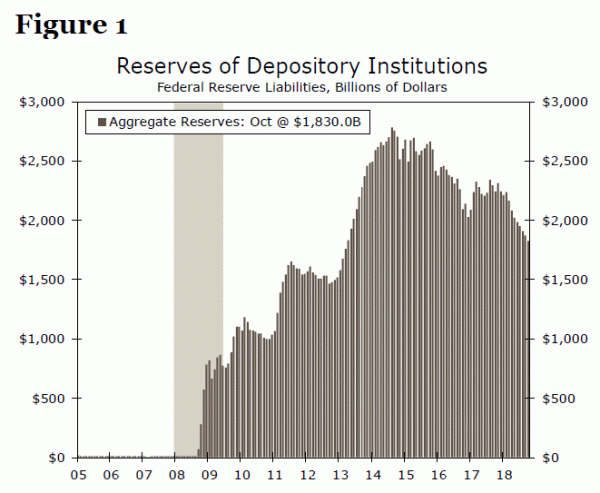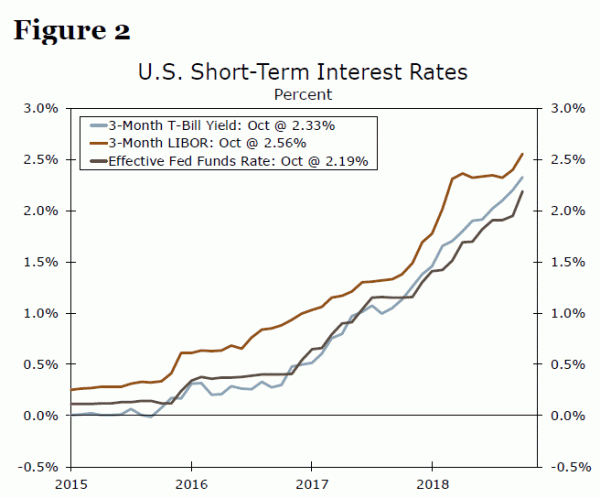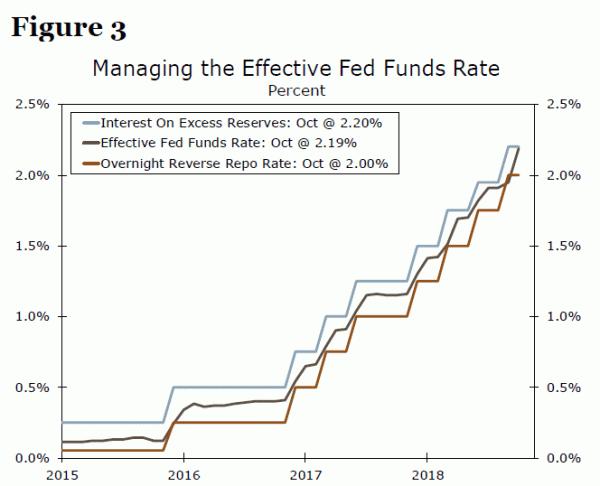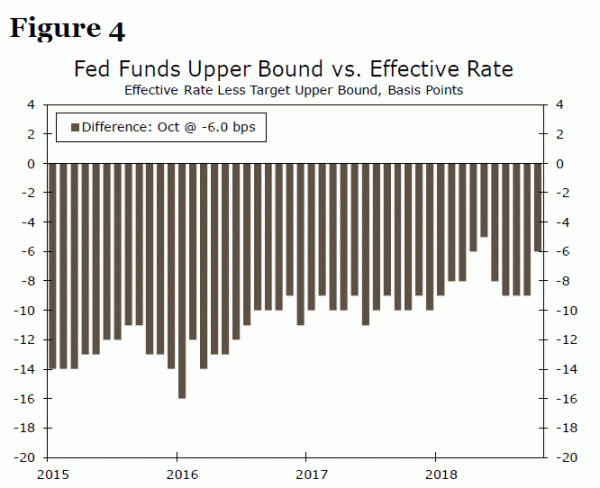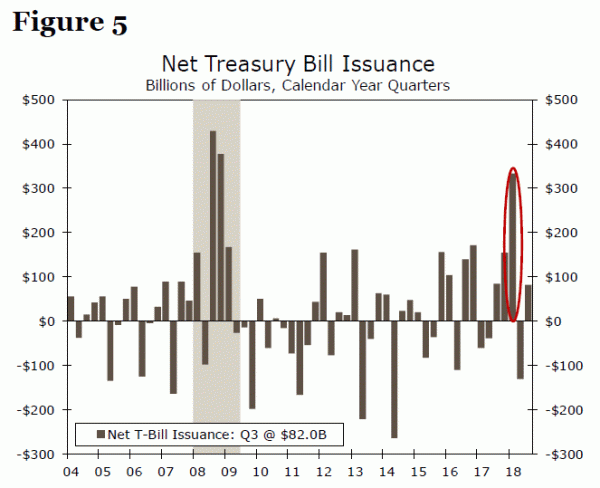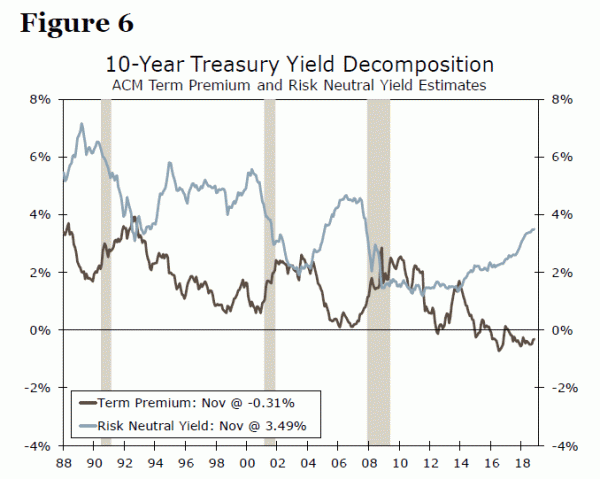Executive Summary
The fed funds rate is the most well-known policy tool in the Federal Reserve’s toolkit. When the Federal Open Market Committee (FOMC) makes its policy decisions, it sets a target range of 25bps in which the effective fed funds rate is permitted to float. The effective fed funds rate, or the actual rate at which financial institutions lend reserves overnight to one another, has recently drifted toward the upper bound of the target range, repeating a phenomenon that occurred earlier this year and eventually led to a “technical adjustment” in the way the Fed operationally influences shortterm interest rates. Minutes from the FOMC’s November meeting released today showed that committee members are again contemplating another technical tweak due to a similar conundrum.1 In this special report, we offer a concise primer on the way the Federal Reserve controls the fed funds rate in the post-crisis era. In addition, we explore some possible causes of this recent upward move in the effective fed funds rate and discuss the implications for the Fed’s balance sheet normalization, the future of monetary policy operations and the interest rate outlook more broadly.
Why Does the Fed Pay Interest on Excess Reserves in the First Place?
At each of its regularly scheduled meetings, the FOMC sets a target range for its main policy rate, the fed funds rate. Prior to the financial crisis, the Fed targeted a single number, while in recent years it has targeted a range, with the upper and lower bounds separated by 25bps. Importantly, the fed funds rate is a market-determined rate, as the supply and demand for reserves determines the market-clearing fed funds rate. In practice, this means that in order for the target to be met, the Federal Reserve must undertake some type of proactive policy to bring the actual fed funds rate inline with the FOMC’s target.
Prior to the financial crisis, the Fed primarily accomplished this by buying or selling Treasury securities through open market operations, thereby influencing the supply of reserves in the fed funds market. To keep the effective fed funds rate from going above the target, the Fed would buy a small amount of Treasury securities, thus increasing the supply of reserves in the system and putting downward pressure on the fed funds rate. Conversely, the Fed would sell a small amount of Treasury securities to push up the fed funds rate.
However, the Fed’s asset purchase programs during and after the Great Recession resulted in an explosion of reserves held at the Federal Reserve, currently totaling more than $1.8 trillion (Figure 1). With a significantly higher level of reserves, the Fed was no longer able to easily manipulate the effective fed funds rate by engaging in small open market operations. As a result, the Fed began utilizing two additional policy levers to control the effective fed funds rate: interest on excess reserves (IOER) and overnight reverse repurchase agreements (ON RRP). In short, these two rates help to anchor the effective fed funds rate within the target range despite the abundance of reserves in the system.2 As seen in Figure 2, the Federal Reserve has been generally quite successful in utilizing these new tools to pull up short-term interest rates in the economy across a range of different financial instruments.
IOER: Coming into Focus Again
Until recently, IOER and ON RRP have been largely successful at keeping the effective fed funds rate within its target range. For most of this cycle, IOER has been set at the upper bound of the FOMC’s target range for the fed funds rate, while the ON RRP has been set at the lower bound, with the effective fed funds rate somewhere in the middle (Figure 3). However, earlier this year the effective fed funds rate began drifting towards the upper bound of the Fed’s target range, narrowing to just 5bps at one point. This led the FOMC to make a “technical adjustment” to the transmission of monetary policy by only increasing the IOER rate by 20bps at its June meeting, whereas the target range for the fed funds rate went up by 25bps. By lifting IOER by a bit less, the effective fed funds rate once again moved back towards the midpoint of the range.
This “technical adjustment” worked for a time, but the issue has begun to creep back into focus. At present, the effective fed funds rate has once again drifted toward the upper bound, and the effective fed funds rate is now essentially equal to IOER (Figures 3 & 4). Why is this happening, and what does it mean for financial market participants and the economy?
Short-Term Factors or a Fundamental Issue?
One explanation put forth has been that a surge in Treasury bill issuance by the federal government has been the source of disruption. As seen in Figure 5, net T-bill supply exploded in the first quarter, with the surge coming for a host of reasons, including the suspension of the debt ceiling, the implementation of the tax cuts and the large seasonal deficit that occurs in Q1.
So what do T-bills have to do with fed funds? When the Treasury issues a slew of T-bills, the primary dealers (banks) buy up the new supply at auction. With an onslaught of supply, the primary dealers are sitting on more T-bills than they probably want or need, so they lend these securities through overnight repurchase agreements. As the primary dealers all compete to lend these securities, supply outstrips demand and the rate they need to offer to clear the market rises. Meanwhile, over in the fed funds market, a parallel market of overnight lending and borrowing, lenders (primarily the government-sponsored enterprises (GSEs), more on them later) see these higher repo rates as an attractive alternative investment. As capital flows towards the more attractive investment in the repo market, the reduced availability of fed funds then puts upward pressure on the fed funds rate, all else equal. Put more simply, a surge in T-bill supply has pushed up rates on repurchase agreements, which in turn have put upward pressure on other overnight interest rates, such as the fed funds rate.
Alternatively, the rising effective fed funds rate could signal a more fundamental scarcity of reserves as the Fed’s balance sheet unwind continues. Just as total reserves rose markedly during the Fed’s asset purchase program, the current shrinking of the Federal Reserve’s balance sheet means the supply of reserves has also been declining. Since the peak in August 2014, total reserves at the Federal Reserve have fallen by almost $1 trillion (Figure 1, front page). Given that the fed funds rate is determined by supply and demand for reserves, a decline in the stock of reserves could lead to more competition for the steadily shrinking supply, putting upward pressure on the fed funds rate.
OK, So Why Should We Care?
These topics are critical for those who spend their time deep in the weeds of short-term interest rates, but a deep dive into the implications for money markets is beyond the scope of this report. We leave it to a future paper to cover this particular sub-topic in greater depth. More fundamentally, there are two key reasons to care about the prospects for the fed funds rate, IOER and monetary policy transmission mechanisms more broadly. First, there is a credibility challenge facing the Federal Reserve. For obvious reasons, the Fed does not want to appear unable to soundly manage its main policy rate. Second, if reserves are becoming truly scarce, balance sheet shrinkage may have to end sooner than anticipated to maintain a sufficient supply of reserves to keep monetary policy functioning effectively.
Thus far, the Federal Reserve has appeared unsympathetic to the argument that reserves are becoming scarce. Minutes from FOMC meetings and Fed speakers suggest policymakers on net put much more stock in the T-bill supply argument. Recent comments from Simon Potter, the Head of the Markets Group at the Federal Reserve Bank of New York, highlight this sentiment: “Let me be clear: Observing the EFFR [effective federal funds rate] and other rates above the IOR [interest on reserves] rate is not a sufficient condition for reserve scarcity. In the last few days, even amid upward pressure in overnight funding rates, we still have not seen the range of signs I described earlier that would indicate reserve scarcity.”3 The minutes from today reinforced this belief, citing that “the upward pressure on the effective fed funds rate and other money market rates reportedly stemmed partly from a sizable increase in Treasury bill supply.”
While this makes sense to us, one has to ask at what point a more permanent solution needs to be reached. If the recent disruptions have stemmed from too much T-bill issuance, perhaps the solution lies in the Treasury Department increasing its reliance on longer-dated Treasury securities to meet the government’s financing need. This solution, however, is largely beyond the Fed’s control. Alternatively, the Federal Reserve could begin buying Treasury bills at some point, either to replace maturing mortgage-backed securities or simply as part of organic balance sheet growth. We covered this possibility in greater detail in part II of our series on the outlook for the Fed’s balance sheet.4
Perhaps more fundamentally, the instrument over which the Fed has the most direct control is the level of reserves, which is tied directly to its balance sheet unwind program. As we have written previously, we expect reserves to stop shrinking sometime in late 2019/early 2020 once they have reached a level of about $1.0-$1.5 trillion.5 But, the appropriate level of reserves is very difficult to pin down, even for the Fed, and this is the first time the Federal Reserve has attempted a maneuver of this type or magnitude. Were the Fed to end the balance sheet unwind even sooner than we anticipate, this would imply an even larger terminal size for the balance sheet, and, in turn, much larger holdings of Treasury securities and/or mortgage-backed securities. These large, perpetual holdings would mean some additional and permanent suppression of long-term interest rates relative to the pre-crisis era, all else equal. The already-negative term premium could remain suppressed for even longer into the current expansion (Figure 6).
A final point we would like to make is that it is not completely unfeasible that, with time, the Federal Reserve could consider alternatives to the fed funds rate as its main policy rate. The minutes hinted at this development, noting that “the staff briefings also examined the tradeoffs between alternative policy rates that the Committee could choose in each of the [limited versus abundant reserve] regimes” and “participants cited several potential benefits of targeting the overnight bank funding rate (OBFR) rather than the effective fed funds rate.” In the pre-crisis era of scarce reserves, the fed funds market was robust, with an estimated average daily volume of more than $250 billion and the majority of activity occurring between banks.6 Today, in a world of abundant reserves, daily volume has dropped substantially to $80 billion or less per day, with the bulk of the trading done by GSEs who hold reserves but are ineligible to earn IOER.
If the balance sheet were to remain much larger than policymakers had originally anticipated, the fed funds market may never return to its former role as a deep, broad interbank market. This in turn means the Federal Reserve may need to undertake a broader rethink of its long-run monetary policy implementation framework, and the minutes from today suggest this process has officially begun. While a new policy rate is currently not our base case, and any hypothetical change would likely take place well into the future, it is worth mentioning as a possible outcome given how different the fed funds market and monetary policy transmission operate today compared to past cycles.
Conclusion: A Technical Issue…for Now
For now, it appears that the Federal Reserve is continuing to treat the effective fed funds rate conundrum as a technical issue. The Fed tweaked IOER at its June meeting, and the minutes from the FOMC’s November meeting released today point to another technical tweak at the December meeting, if not before then. For most market participants, this will mean nothing more than an effective fed funds rate that, for now, is pushed back closer to the middle of the Fed’s target range.
However, with two technical tweaks possible in the span of six months, the stars appear to be aligning for a broader and deeper look at the Fed’s monetary policy tools and outlook. Our baseline scenario remains that the Fed will end its balance sheet unwind by late 2019/early 2020, but there is a risk that continued challenges in the fed funds market could precipitate an even earlier end.
1 https://www.federalreserve.gov/monetarypolicy/files/fomcminutes20181108.pdf
2 For a deeper dive into the nuanced way these rates operate in practice, see: Williamson, Stephen D. (2015). “Monetary Policy Normalization in the United States.” Federal Reserve Bank of St. Louis Review.
3 Potter, Simon. “U.S. Monetary Policy Normalization is Proceeding Smoothly.” Remarks at the China Finance 40 Forum – Euro 50 Group – CIGI Roundtable, Banque de France, Paris, France.
4 Bryson, Jay H., Pugliese, M. and Vaisey, A., “Will the Fed’s Balance Sheet Ever Return to ‘Normal’? Part I.” (August 29, 2018), and Bryson, Jay H., Pugliese, M. and Vaisey, A., “Will the Fed’s Balance Sheet Ever Return to ‘Normal’? Part II.” (September 5, 2018).
5 Ibid
6 Afonso, Gara, Armenter, R., and Lester, B. “A Model of the Federal Funds Market: Yesterday, Today, and Tomorrow.” (February 2018).




